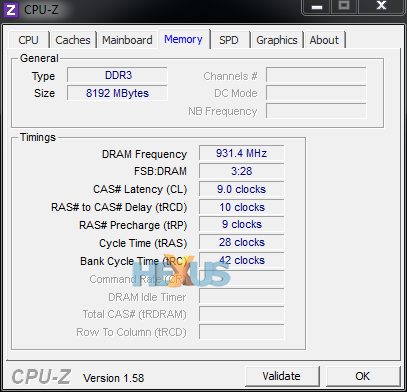How we test

Comparison Memory |
||
|---|---|---|
| G.Skill RipjawsX 8GB | Corsair Vengeance 8GB | |
| Model Number | F3-14900CL9D-8GBXL | CMZ8GX3M2A1600C9 |
| Capacity | 8GB (2x4GB) | 8GB (2x4GB) |
| Speed | 1,866MHz DDR3 | 1,600MHz DDR3 |
| Timings | 9-10-9-28-2T | 9-9-9-24-2T |
| Voltage | 1.50V | 1.50V |
| Price* | £70 | £65 |
| Cost per GB* | £8.75 | £8.12 |
| *Approximate, correct at time of writing | ||
Intel Test bench |
|||||||||
|---|---|---|---|---|---|---|---|---|---|
| CPU | Intel Core i5 2500K (3.3GHz, 6MB L3 cache, quad-core, LGA1155) | ||||||||
| Motherboard | Intel DP67BG | ||||||||
| Storage device | Crucial 256GB RealSSD C300 (SATA 6Gbps) | ||||||||
| Graphics card | NVIDIA GeForce GTX 560 Ti (1,024MB, ForceWare 266.66) | ||||||||
| Power supply | Corsair AX750 | ||||||||
| Operating system | Windows 7 Ultimate SP1, 64-bit | ||||||||
AMD Test bench |
|||||||||
|---|---|---|---|---|---|---|---|---|---|
| CPU | AMD A8-3850 (2.9GHz, quad-core, FM1) | ||||||||
| Motherboard | ASRock A75-Pro4 | ||||||||
| Storage device | Crucial 256GB RealSSD C300 (SATA 6Gbps) | ||||||||
| Graphics card | Integrated graphics - Radeon HD 6550D | ||||||||
| Power supply | Zalman 400W | ||||||||
| Operating system | Windows 7 Ultimate SP1, 64-bit | ||||||||
Benchmarks |
|---|
| AIDA64 v1.60.1300 (download) |
| HEXUS.PiFast (download) |
| Cinebench R11.5 (download) |
| 3DMark 11 v1.0.1.0 (download) |
| Just Cause 2 (homepage) |
| Power Consumption |
Testing methodology
The Intel-based machine can be considered mid-to-high-end, as it takes in a decent CPU and discrete graphics card from NVIDIA. The premise here is to evaluate whether faster memory - going from DDR3-1,600 to DDR3-1,866 - makes a difference for an already-quality system.
The AMD system takes a different tack, however. It's decidedly cheaper and uses the A8-3850 APU, with graphics powered via the on-board Radeon HD 6550D part of the chip. This system should be more partial to memory-speed changes; both the CPU cores and GPU can fight for the same RAM usage
The same benchmarks are run on both systems save for a reduction in the quality settings in 3DMark11 and Just Cause 2 for the AMD system - integrated graphics cannot compete with a £150-plus discrete card.
Overclocking
When it comes to memory overclocking, Intel's Sandy Bridge offers little-to-no wiggle room for adjusting the system base clock, leaving users one option; increase the memory multiplier.
With that in mind, we're providing a very rough estimate of the overclocking ability of our two comparison memory kits. We start by levelling the playing field by running the duo with modest 9-9-9-24 latencies at 1.65V, and then go up to 12x, 14x and 16x multipliers, to see which modules maintain stability at the increased speeds.
1,600MHz (9-9-9-24-2T) |
1,866MHz (9-9-9-24-2T) |
2,133MHz (9-9-9-24-2T) |
|
|---|---|---|---|
| G.Skill Ripjaws-X 8GB (F3-14900CL9D-8GBXL) |
|||
| Corsair Vengeance 8GB (CMZ8GX3M2A1600C90) |
The G.Skill kit actually runs the 9-9-9-24-2T timings at the default 1.50V. Increasing it to 1.65V makes it stable at around 2,000MHz (adjusting base clock), but it wouldn't quite stretch to 2,133MHz even when timings were further loosened off.
Latencies flexibility
Keeping the default 1.50V active, the modules had no trouble in running at 1,600MHz with 8-8-8-24 timings and 1,333MHz with tight 7-7-7-21 latencies.









